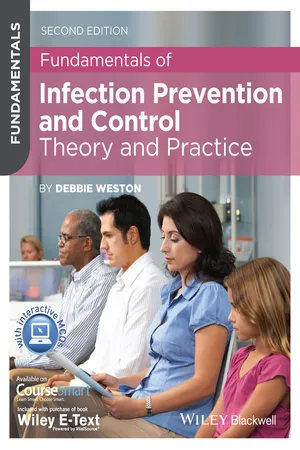
- English
- ePUB (mobile friendly)
- Available on iOS & Android
About This Book
Reviews of first edition:
"This book tells every healthcare professional all they need to know about infection control… A user-friendly, valuable source of knowledge on a subject that can be confusing and complicated." Nursing Standard
"A valuable contribution within any health or social environment." Journal of Community Nursing
Infection prevention and control is an essential component of nursing care, and a crucially important subject area for both nursing students and qualified nurses. Fundamentals of Infection Prevention and Control gives readers a firm grasp of the principles of infection control, how they relate to clinical practice and the key issues surrounding the subject. It provides a comprehensive guide to the prevention, management and control of healthcare associated infections, and the basic elements of microbiology, immunology and epidemiology that underpin them.
Thoroughly revised in line with current policy, this new edition contains brand-new chapters on a range of topics including the role of the Infection Prevention and Control Team, audit and surveillance, and the management of outbreaks. Also incorporating a range of case studies and examples as well as additional online content, it is essential reading for all nursing students as well as qualified nursing and healthcare professionals.
- Explores both principles and practice of a crucial subject area
- Accessible and user-friendly, with a range of features to help study including key definitions, links back to clinical practice, and chapter learning outcomes and summaries
- Accompanied by an online resource centre featuring MCQs, weblinks, case scenarios and downloadable fact sheets
- Features an increased clinical focus, with more application to practice
This title is also available:
- as a Wiley E-Text, powered by VitalSource: an interactive digital version of the book featuring downloadable text and images, highlighting and note-taking facilities, book-marking, cross-referencing, in-text searching, and linking to references and glossary terms
- instantly on CourseSmart at www.coursesmart.co.uk/9781118306659. CourseSmart offers extra
functionality, as well as an immediate way to review the text. For more details, visit www.coursesmart.com/instructors or www.coursesmart.com/students
Frequently asked questions
Information
Introduction
- Define healthcare-associated infections (HCAIs).
- List six patient risk factors for the development of HCAIs.
- List 10 general factors that can increase the risk of HCAIs.
- List six ways in which HCAIs can affect patients and healthcare providers.
- Understand the continuing threat to public health from old and new diseases.
Background
The problem of HCAIs
- The prevalence of HCAIs in low and middle-income countries varies between 5.7% and 19.1%.
- Infection rates in newborn babies are 3–20 times higher in low and middle-income countries than in developed or high-income countries; in the former, HCAIs are responsible for 4–56% of deaths in the neonatal period (and 75% of neonatal deaths in Southeast Asia and Sub-Saharan Africa).
- The proportion of patients with infections acquired in intensive care units in low- and middle-income countries ranges from 4.4% to 88.9%.
- The incidence of surgical site infections is up to nine times higher than in developed countries.
- Hospital-acquired infections (as they were referred to then) were responsible for the deaths of 5000 patients in the United Kingdom each year.
- HCAIs were probably a contributing factor, but not the primary cause, in at least 15 000 other deaths.
- At any one time, one in 10 patients receiving care in acute hospitals had a hospital-acquired infection, and a significant but undetermined number of patients discharged from hospital into the community also had, or developed, infections related to their hospital stay.
- While it was not possible to prevent all infections, there were several recognised risk factors which increased the risk to patients.
- Between 15 to 30% of infections could be prevented through good clinical or infection control practice.
- Of hospital in-patients, 7.8% had one or more hospital-acquired infections, and 19.1% of patients reported symptoms of infection post discharge.
- Costs associated with treati...
Table of contents
- Cover
- Titles of related interest
- Website ad
- Title page
- Copyright page
- About the series
- Preface
- How to get the best out of your textbook
- How to use the companion website
- Acknowledgements
- Introduction
- Part One: Introduction to infection prevention and control
- Part Two: The principles of infection prevention and control (standard precautions)
- Part Three: Clinical practice
- Part Four: Specific organisms
- Glossary
- Index